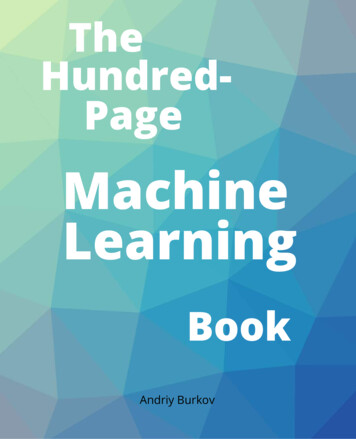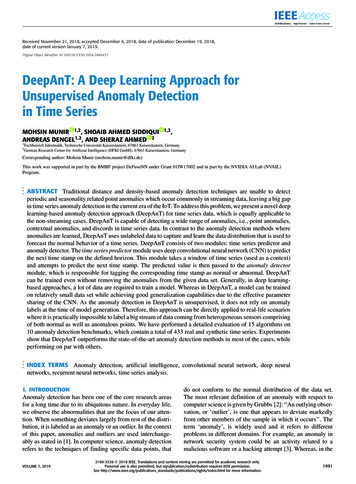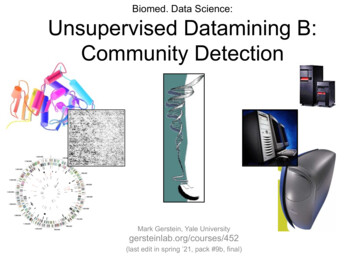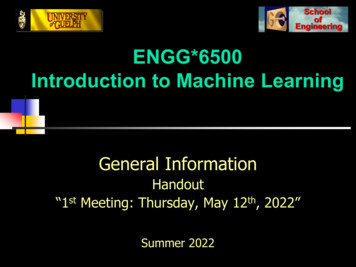
Transcription
Unsupervised Learning Zoubin Ghahramani†Gatsby Computational Neuroscience UnitUniversity College London, uk/ zoubinSeptember 16, 2004AbstractWe give a tutorial and overview of the field of unsupervised learning from the perspective of statisticalmodelling. Unsupervised learning can be motivated from information theoretic and Bayesian principles.We briefly review basic models in unsupervised learning, including factor analysis, PCA, mixtures ofGaussians, ICA, hidden Markov models, state-space models, and many variants and extensions. Wederive the EM algorithm and give an overview of fundamental concepts in graphical models, and inferencealgorithms on graphs. This is followed by a quick tour of approximate Bayesian inference, includingMarkov chain Monte Carlo (MCMC), Laplace approximation, BIC, variational approximations, andexpectation propagation (EP). The aim of this chapter is to provide a high-level view of the field. Alongthe way, many state-of-the-art ideas and future directions are also reviewed.Contents1 Introduction1.1 What is unsupervised learning? . . . . . . . . . . . . . . . . . . . . . . . . . . . . . . . . . . .1.2 Machine learning, statistics, and information theory . . . . . . . . . . . . . . . . . . . . . . .1.3 Bayes rule . . . . . . . . . . . . . . . . . . . . . . . . . . . . . . . . . . . . . . . . . . . . . . .33442 Latent variable models2.1 Factor analysis . . . . . . . . . . . . . .2.2 Principal components analysis (PCA) .2.3 Independent components analysis (ICA)2.4 Mixture of Gaussians . . . . . . . . . . .2.5 K-means . . . . . . . . . . . . . . . . . .667778.3 The EM algorithm4 Modelling time series and other structured4.1 State-space models (SSMs) . . . . . . . . .4.2 Hidden Markov models (HMMs) . . . . . .4.3 Modelling other structured data . . . . . . .8data. . . . . . . . . . . . . . . . . . . . . . . . . . . . . . . . . . . . . . . . . . . . . . . . . . . . . . . . . . . . . . . . . . . . . . . . . . . . . . . . . .91010115 Nonlinear, Factorial, and Hierarchical Models116 Intractability12 Thischapter will appear in Bousquet, O., Raetsch, G. and von Luxburg, U. (eds) Advanced Lectures on Machine LearningLNAI 3176. c Springer-Verlag.† The author is also at the Center for Automated Learning and Discovery, Carnegie Mellon University, USA.1
7 Graphical models7.1 Undirected graphs7.2 Factor graphs . . .7.3 Directed graphs . .7.4 Expressive power .13131414158 Exact inference in graphs8.1 Elimination . . . . . . . .8.2 Belief propagation . . . .8.3 Factor graph propagation8.4 Junction tree algorithm .8.5 Cutest conditioning . . . .1516161818199 Learning in graphical models9.1 Learning graph parameters . . .9.1.1 The complete data case. .9.1.2 The incomplete data case.9.2 Learning graph structure . . . . .9.2.1 Scoring metrics. . . . . .9.2.2 Search algorithms. . . . .19202020212121.10 Bayesian model comparison and Occam’s Razor11 Approximating posteriors and marginal likelihoods11.1 Laplace approximation . . . . . . . . . . . . . . . . .11.2 The Bayesian information criterion (BIC) . . . . . .11.3 Markov chain Monte Carlo (MCMC) . . . . . . . . .11.4 Variational approximations . . . . . . . . . . . . . .11.5 Expectation propagation (EP) . . . . . . . . . . . .12 Conclusion21.222323242425272
1IntroductionMachine learning is the field of research devoted to the formal study of learning systems. This is a highlyinterdisciplinary field which borrows and builds upon ideas from statistics, computer science, engineering,cognitive science, optimisation theory and many other disciplines of science and mathematics. The purposeof this chapter is to introduce in a fairly concise manner the key ideas underlying the sub-field of machinelearning known as unsupervised learning. This introduction is necessarily incomplete given the enormousrange of topics under the rubric of unsupervised learning. The hope is that interested readers can delvemore deeply into the many topics covered here by following some of the cited references. The chapter startsat a highly tutorial level but will touch upon state-of-the-art research in later sections. It is assumed thatthe reader is familiar with elementary linear algebra, probability theory, and calculus, but not much else.1.1What is unsupervised learning?Consider a machine (or living organism) which receives some sequence of inputs x1 , x2 , x3 , . . ., where xt isthe sensory input at time t. This input, which we will often call the data, could correspond to an image onthe retina, the pixels in a camera, or a sound waveform. It could also correspond to less obviously sensorydata, for example the words in a news story, or the list of items in a supermarket shopping basket.One can distinguish between four different kinds of machine learning. In supervised learning the machine1is also given a sequence of desired outputs y1 , y2 , . . . , and the goal of the machine is to learn to produce thecorrect output given a new input. This output could be a class label (in classification) or a real number (inregression).In reinforcement learning the machine interacts with its environment by producing actions a1 , a2 , . . .These actions affect the state of the environment, which in turn results in the machine receiving some scalarrewards (or punishments) r1 , r2 , . . . The goal of the machine is to learn to act in a way that maximisesthe future rewards it receives (or minimises the punishments) over its lifetime. Reinforcement learning isclosely related to the fields of decision theory (in statistics and management science), and control theory(in engineering). The fundamental problems studied in these fields are often formally equivalent, and thesolutions are the same, although different aspects of problem and solution are usually emphasised.A third kind of machine learning is closely related to game theory and generalises reinforcement learning.Here again the machine gets inputs, produces actions, and receives rewards. However, the environment themachine interacts with is not some static world, but rather it can contain other machines which can alsosense, act, receive rewards, and learn. Thus the goal of the machine is to act so as to maximise rewards inlight of the other machines’ current and future actions. Although there is a great deal of work in game theoryfor simple systems, the dynamic case with multiple adapting machines remains an active and challengingarea of research.Finally, in unsupervised learning the machine simply receives inputs x1 , x2 , . . ., but obtains neither supervised target outputs, nor rewards from its environment. It may seem somewhat mysterious to imagine whatthe machine could possibly learn given that it doesn’t get any feedback from its environment. However, itis possible to develop of formal framework for unsupervised learning based on the notion that the machine’sgoal is to build representations of the input that can be used for decision making, predicting future inputs,efficiently communicating the inputs to another machine, etc. In a sense, unsupervised learning can bethought of as finding patterns in the data above and beyond what would be considered pure unstructurednoise. Two very simple classic examples of unsupervised learning are clustering and dimensionality reduction.We discuss these in Section 2. The remainder of this chapter focuses on unsupervised learning, althoughmany of the concepts discussed can be applied to supervised learning as well. But first, let us consider howunsupervised learning relates to statistics and information theory.1 Henceforth, for succinctness I’ll use the term machine to refer both to machines and living organisms. Some people prefer tocall this a system or agent. The same mathematical theory of learning applies regardless of what we choose to call the learner,whether it is artificial or biological.3
1.2Machine learning, statistics, and information theoryAlmost all work in unsupervised learning can be viewed in terms of learning a probabilistic model of thedata. Even when the machine is given no supervision or reward, it may make sense for the machine toestimate a model that represents the probability distribution for a new input xt given previous inputsx1 , . . . , xt 1 (consider the obviously useful examples of stock prices, or the weather). That is, the learnermodels P (xt x1 , . . . , xt 1 ). In simpler cases where the order in which the inputs arrive is irrelevant orunknown, the machine can build a model of the data which assumes that the data points x1 , x2 , . . . areindependently and identically drawn from some distribution P (x)2 .Such a model can be used for outlier detection or monitoring. Let x represent patterns of sensor readingsfrom a nuclear power plant and assume that P (x) is learned from data collected from a normally functioningplant. This model can be used to evaluate the probability of a new sensor reading; if this probability isabnormally low, then either the model is poor or the plant is behaving abnormally, in which case one maywant to shut it down.A probabilistic model can also be used for classification. Assume P1 (x) is a model of the attributes ofcredit card holders who paid on time, and P2 (x) is a model learned from credit card holders who defaultedon their payments. By evaluating the relative probabilities P1 (x0 ) and P2 (x0 ) on a new applicant x0 , themachine can decide to classify her into one of these two categories.With a probabilistic model one can also achieve efficient communication and data compression. Imaginethat we want to transmit, over a digital communication line, symbols x randomly drawn from P (x). Forexample, x may be letters of the alphabet, or images, and the communication line may be the internet.Intuitively, we should encode our data so that symbols which occur more frequently have code words withfewer bits in them, otherwise we are wasting bandwidth. Shannon’s source coding theorem quantifies this bytelling us that the optimal number of bits to use to encode a symbol with probability P (x) is log2 P (x).Using these number of bits for each symbol, the expected coding cost is the entropy of the distribution P .XdefH(P ) P (x) log2 P (x)(1)xIn general, the true distribution of the data is unknown, but we can learn a model of this distribution. Let’scall this model Q(x). The optimal code with respect to this model would use log2 Q(x) bits for each symbolx. The expected coding cost, taking expectations with respect to the true distribution, isX P (x) log2 Q(x)(2)xThe difference between these two coding costs is called the Kullback-Leibler (KL) divergencedefKL(P kQ) XxP (x) logP (x)Q(x)(3)The KL divergence is non-negative and zero if and only if P Q. It measures the coding inefficiency in bitsfrom using a model Q to compress data when the true data distribution is P . Therefore, the better ourmodel of the data, the more efficiently we can compress and communicate new data. This is an importantlink between machine learning, statistics, and information theory. An excellent text which elaborates onthese relationships and many of the topics in this chapter is [48].1.3Bayes ruleBayes rule,P (y x) P (x y)P (y)P (x)(4)which follows from the equality P (x, y) P (x)P (y x) P (y)P (x y), can be used to motivate a coherentstatistical framework for machine learning. The basic idea is the following. Imagine we wish to design a2 We will use both P and p to denote probability distributions and probability densities. The meaning should be cleardepending on whether the argument is discrete or continuous.4
machine which has beliefs about the world, and updates these beliefs on the basis of observed data. Themachine must somehow represent the strengths of its beliefs numerically. It has been shown that if youaccept certain axioms of coherent inference, known as the Cox axioms, then a remarkable result follows[36]: If the machine is to represent the strength of its beliefs by real numbers, then the only reasonable andcoherent way of manipulating these beliefs is to have them satisfy the rules of probability, such as Bayesrule. Therefore, P (X x) can be used not only to represent the frequency with which the variable X takeson the value x (as in so-called frequentist statistics) but it can also be used to represent the degree of beliefthat X x. Similarly, P (X x Y y) can be used to represent the degree of belief that X x given thatone knowns Y y.3From Bayes rule we derive the following simple framework for machine learning. Assume a universe ofmodels Ω; let Ω {1, . . . , M } although it need not be finite or even countable. The machines starts with somePMprior beliefs over models m Ω (we will see many examples of models later), such that m 1 P (m) 1.A model is simply some probability distribution over data points, i.e. P (x m). For simplicity, let us furtherassume that in all the models the data is taken to be independently and identically distributed (iid). Afterobserving a data set D {x1 , . . . , xN }, the beliefs over models is given by:P (m D) NYP (m)P (D m) P (m)P (xn m)P (D)n 1(5)which we read as the posterior over models is the prior multiplied by the likelihood, normalised.The predictive distribution over new data, which would be used to encode new data efficiently, isP (x D) MXP (x m)P (m D)(6)m 1Again this follows from the rules of probability theory, and the fact that the models are assumed to produceiid data.Often models are defined by writing down a parametric probability distribution (again, we’ll see manyexamples below). Thus, the model m might have parameters θ, which are assumed to be unknown (thiscould in general be a vector of parameters). To be a well-defined model from the perspective of Bayesianlearning, one has to define a prior over these model parameters P (θ m) which naturally has to satisfy thefollowing equalityZP (x m) P (x θ, m)P (θ m)dθ(7)Given the model m it is also possible to infer the posterior over the parameters of the model, i.e. P (θ D, m),and to compute the predictive distribution, P (x D, m). These quantities are derived in exact analogy toequations (5) and (6), except that instead of summing over possible models, we integrate over parameters ofa particular model. All the key quantities in Bayesian machine learning follow directly from the basic rulesof probability theory.Certain approximate forms of Bayesian learning are worth mentioning. Let’s focus on a particular modelm with parameters θ, and an observed data set D. The predictive distribution averages over all possibleparameters weighted by the posteriorZP (x D, m) P (x θ)P (θ D, m)dθ.(8)In certain cases, it may be cumbersome to represent the entire posterior distribution over parameters, soinstead we will choose to find a point-estimate of the parameters θ̂. A natural choice is to pick the most3 Another way to motivate the use of the rules of probability to encode degrees of belief comes from game-theoretic argumentsin the form of the Dutch Book Theorem. This theorem states that if you are willing to accept bets with odds based on yourdegrees of beliefs, then unless your beliefs are coherent in the sense that they satisfy the rules of probability theory, there existsa set of simultaneous bets (called a “Dutch Book”) which you will accept and which is guaranteed to lose you money, no matterwhat the outcome. The only way to ensure that Dutch Books don’t exist against you, is to have degrees of belief that satisfyBayes rule and the other rules of probability theory.5
probable parameter value given the data, which is known as the maximum a posteriori or MAP parameterestimate#"Xlog P (xn θ, m)(9)θ̂MAP arg max P (θ D, m) arg max log P (θ m) θθnAnother natural choice is the maximum likelihood or ML parameter estimateXθ̂ML arg max P (D θ, m) arg maxlog P (xn θ, m)θθ(10)nMany learning algorithms can be seen as finding ML parameter estimates. The ML parameter estimate isalso acceptable from a frequentist statistical modelling perspective since it does not require deciding on aprior over parameters. However, ML estimation does not protect against overfitting—more complex modelswill generally have higher maxima of the likelihood. In order to avoid problems with overfitting, frequentistprocedures often maximise a penalised or regularised log likelihood (e.g. [26]). If the penalty or regularisationterm is interpreted as a log prior, then maximising penalised likelihood appears identical to maximising aposterior. However, there are subtle issues that make a Bayesian MAP procedure and maximum penalisedlikelihood different [28]. One difference is that the MAP estimate is not invariant to reparameterisation,while the maximum of the penalised likelihood is invariant. The penalised likelihood is a function, not adensity, and therefore does not increase or decrease depending on the Jacobian of the reparameterisation.2Latent variable modelsThe framework described above can be applied to a wide range of models. No singe model is appropriatefor all data sets. The art in machine learning is to develop models which are appropriate for the data setbeing analysed, and which have certain desired properties. For example, for high dimensional data sets itmight be necessary to use models that perform dimensionality reduction. Of course, ultimately, the machineshould be able to decide on the appropriate model without any human intervention, but to achieve this infull generality requires significant advances in artificial intelligence.In this section, we will consider probabilistic models that are defined in terms of some latent or hiddenvariables. These models can be used to do dimensionality reduction and clustering, the two cornerstones ofunsupervised learning.2.1Factor analysisLet the data set D consist of D-dimensional real valued vectors, D {y1 , . . . , yN }. In factor analysis, thedata is assumed to be generated from the following modely Λx (11)where x is a K-dimensional zero-mean unit-variance multivariate Gaussian vector with elements corresponding to hidden (or latent) factors, Λ is a D K matrix of parameters, known as the factor loading matrix,and is a D-dimensional zero-mean multivariate Gaussian noise vector with diagonal covariance matrix Ψ.Defining the parameters of the model to be θ (Ψ, Λ), by integrating out the factors, one can readily derivethatZp(y θ) p(x θ)p(y x, θ)dx N (0, ΛΛ Ψ)(12)where N (µ, Σ) refers to a multivariate Gaussian density with mean µ and covariance matrix Σ. For moredetails refer to [68].Factor analysis is an interesting model for several reasons. If the data is very high dimensional (D islarge) then even a simple model like the full-covariance multivariate Gaussian will have too many parametersto reliably estimate or infer from the data. By choosing K D, factor analysis makes it possible to modela Gaussian density for high dimensional data without requiring O(D2 ) parameters. Moreover, given a newdata point, one can compute the posterior over the hidden factors, p(x y, θ); since x is lower dimensionalthan y this provides a low-dimensional representation of the data (for example, one could pick the mean ofp(x y, θ) as the representation for y).6
2.2Principal components analysis (PCA)Principal components analysis (PCA) is an important limiting case of factor analysis (FA). One can derivePCA by making two modifications to FA. First, the noise is assumed to be isotropic, in other words eachelement of has equal variance: Ψ σ 2 I, where I is a D D identity matrix. This model is called probabilisticPCA [67, 78]. Second, if we take the limit of σ 0 in probabilistic PCA, we obtain standard PCA (whichalso goes by the names Karhunen-Loève expansion, and singular value decomposition; SVD). Given a dataset with covariance matrix Σ, for maximum likelihood factor analysis the goal is to find parameters Λ, andΨ for which the model ΛΛ Ψ has highest likelihood. In PCA, the goal is to find Λ so that the likelihood ishighest for ΛΛ . Note that this matrix is singular unless K D, so the standard PCA model is not a sensiblemodel. However, taking the limiting case, and further constraining the columns of Λ to be orthogonal, itcan be derived that the principal components correspond to the K eigenvectors with largest eigenvalue ofΣ. PCA is thus attractive because the solution can be found immediately after eigendecomposition of thecovariance. Taking the limit σ 0 of p(x y, Λ, σ) we find that it is a delta-function at x Λ y, which isthe projection of y onto the principal components.2.3Independent components analysis (ICA)Independent components analysis (ICA) extends factor analysis to the case where the factors are nonGaussian. This is an interesting extension because many real-world data sets have structure which can bemodelled as linear combinations of sparse sources. This includes auditory data, images, biological signalssuch as EEG, etc. Sparsity simply corresponds to the assumption that the factors have distributions withhigher kurtosis that the Gaussian. For example, p(x) λ2 exp{ λ x } has a higher peak at zero and heaviertails than a Gaussian with corresponding mean and variance, so it would be considered sparse (strictlyspeaking, one would like a distribution which had non-zero probability mass at 0 to get true sparsity).Models like PCA, FA and ICA can all be implemented using neural networks (multilayer perceptrons)trained using various cost functions. It is not clear what advantage this implementation/interpretation hasfrom a machine learning perspective, although it provides interesting ties to biological information processing.Rather than ML estimation, one can also do Bayesian inference for the parameters of probabilistic PCA,FA, and ICA.2.4Mixture of GaussiansThe densities modelled by PCA, FA and ICA are all relatively simple in that they are unimodal and havefairly restricted parametric forms (Gaussian, in the case of PCA and FA). To model data with more complexstructure such as clusters, it is very useful to consider mixture models. Although it is straightforward toconsider mixtures of arbitrary densities, we will focus on Gaussians as a common special case. The densityof each data point in a mixture model can be written:p(y θ) KXπk p(y θk )(13)k 1where each of the K components of the mixture is, for example, a Gaussian with differingPK means andcovariances θk (µk , Σk ) and πk is the mixing proportion for component k, such that k 1 πk 1 andπk 0, k.A different way to think about mixture models is to consider them as latent variable models, whereassociated with each data point is a K-ary discrete latent (i.e. hidden) variable s which has the interpretationthat s k if the data point was generated by component k. This can be writtenp(y θ) KXP (s k π)p(y s k, θ)(14)k 1where P (s k π) πk is the prior for the latent variable taking on value k, and p(y s k, θ) p(y θk ) isthe density under component k, recovering Equation (13).7
2.5K-meansThe mixture of Gaussians model is closely related to an unsupervised clustering algorithm known as k-meansas follows: Consider the special case where all the Gaussians have common covariance matrix proportionalto the identity matrix: Σk σ 2 I, k, and let πk 1/K, k. We can estimate the maximum likelihoodparameters of this model using the iterative algorithm which we are about to describe, known as EM. Theresulting algorithm, as we take the limit σ 2 0, becomes exactly the k-means algorithm. Clearly the modelunderlying k-means has only singular Gaussians and is therefore an unreasonable model of the data; however,k-means is usually justified from the point of view of clustering to minimise a distortion measure, ratherthan fitting a probabilistic models.3The EM algorithmThe EM algorithm is an algorithm for estimating ML parameters of a model with latent variables. Considera model with observed variables y, hidden/latent variables x, and parameters θ. We can lower bound thelog likelihood for any data point as followsZL(θ) log p(y θ) log p(x, y θ) dx(15)Zp(x, y θ)dx(16) log q(x)q(x)Zp(x, y θ)def q(x) logdx F (q, θ)(17)q(x)where q(x) is some arbitrary density over the hidden variables, and the lower bound holds due to the concavityof the log function (this inequality is known as Jensen’s inequality). The lower bound F is a functional ofboth the density q(x) and the model parameters θ. For a data set of N data points y(1) , . . . , y(N ) , this lowerbound is formed for the log likelihoodPterm corresponding to each data point, thus there is a separate densityq (n) (x) for each point and F (q, θ) n F (n) (q (n) , θ).The basic idea of the Expectation-Maximisation (EM) algorithm is to iterate between optimising thislower bound as a function of q and as a function of θ. We can prove that this will never decrease thelog likelihood. After initialising the parameters somehow, the k th iteration of the algorithm consists of thefollowing two steps:E step: optimise F with respect to the distribution q while holding the parameters fixedZp(x, y θk 1 )qk (x) arg max q(x) log(18)q(x)q(x)qk (x) p(x y, θk 1 )(19)M step: optimise F with respect to the parameters θ while holding the distribution over hidden variablesfixedZp(x, y θ)θk arg max qk (x) logdx(20)θqk (x)Zθk arg max qk (x) log p(x, y θ) dx(21)θLet us be absolutely clear what happens for a data set of N data points: In the E step, for each data point,(n)the distribution over the hidden variables is set to the posterior for that data point qk (x) p(x y(n) , θk 1 ), n. In the M step the single set of parameters is re-estimated by maximising the sum of the expected logP R (n)likelihoods: θk arg maxθ n qk (x) log p(x, y(n) θ) dx.Two things are still unclear: how does (19) follow from (18), and how is this algorithm guaranteed to increase the likelihood? The optimisation in (18) can be written as follows since p(x, y θk 1 ) p(y θk 1 )p(x y, θk 1 ):Zhip(x y, θk 1 )qk (x) arg max log p(y θk 1 ) q(x) logdx(22)q(x)q(x)8
Now, the first term is a constant w.r.t. q(x) and the second term is the negative of the Kullback-LeiblerdivergenceZq(x)KL(q(x)kp(x y, θk 1 )) q(x) logdx(23)p(x y, θk 1 )which we have seen in Equation (3) in its discrete form. This is minimised at q(x) p(x y, θk 1 ), where theKL divergence is zero. Intuitively, the interpretation of this is that in the E step of EM, the goal is to findthe posterior distribution of the hidden variables given the observed variables and the current settings of theparameters. We also see that since the KL divergence is zero, at the end of the E step, F (qk , θk 1 ) L(θk 1 ).In the M step, F is increased with respect to θ. Therefore, F (qk , θk ) F (qk , θk 1 ). Moreover,L(θk ) F (qk 1 , θk ) F (qk , θk ) after the next E step. We can put these steps together to establishthat L(θk ) L(θk 1 ), establishing that the algorithm is guaranteed to increase the likelihood or keep itfixed (at convergence).The EM algorithm can be applied to all the latent variable models described above, i.e. FA, probabilisticPCA, mixture models, and ICA. In the case of mixture models, the hidden variable is the discrete assignment s of data points to clusters; consequently the integrals turn into sums where appropriate. EM haswide applicability to latent variable models, although it is not always the fastest optimisation method [70].Moreover, we should note that the likelihood often has many local optima and EM will converge some localoptimum which may not be the global one.EM can also be used to estimate MAP parameters of a model, and as we will see in Section 11.4 there isa Bayesian generalization of EM as well.4Modelling time series and other structured dataSo far we have assumed that the data is unstructured, that is, the observations are assumed to be independentand identically distributed. This assumption is unreasonable for many data sets in which the observationsarrive in a sequence and subsequent observations are correlated. Sequential data can occur in time seriesmodelling (as in financial data or the weather) and also in situations where the sequential nature of the datais not necessarily tied to time (as in protein data which consist of sequences of amino acids).As the most basic level, time series modelling consists of building a probabilistic model of the presentobservation given all past observations p(yt yt 1 , yt 2 . . .). Because the history of observations grows arbitrarily large it is necessary to limit the complexity of such a model. There are essentially two ways of doingthis.The first approach is to limit the window of past observations. Thus one can simply model p(yt yt 1 )and assume that this relation holds for all t. This is known as a first-order Markov model. A second-orderMarkov model would be p(yt yt 1 , yt 2 ), and so on. Such Markov models have two limitations: First, theinfluence of past observations on present observations vanishes outside this window, which can be unrealistic.Second, it may be unnatural and unwieldy to mode
1.2 Machine learning, statistics, and information theory Almost all work in unsupervised learning can be viewed in terms of learning a probabilistic model of the data. Even when the machine is given no supervision or reward, it may make sense for the machine to estimate a model that represents the probability distribution for a new input x










